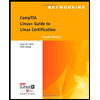
Computer Systems: A Programmer's Perspective (3rd Edition)
3rd Edition
ISBN: 9780134092669
Author: Bryant, Randal E. Bryant, David R. O'Hallaron, David R., Randal E.; O'Hallaron, Bryant/O'hallaron
Publisher: PEARSON
expand_more
expand_more
format_list_bulleted
Question
Chapter 6.1, Problem 6.5PP
A.
Program Plan Intro
Lifetime of SSD:
Intel guarantees about 128 petabytes or PB (
1 PB =
B.
Program Plan Intro
Lifetime of SSD:
Intel guarantees about 128 petabytes or PB (
1 PB =
C.
Program Plan Intro
Lifetime of SSD:
Intel guarantees about 128 petabytes or PB (
1 PB =
Expert Solution & Answer
Want to see the full answer?
Check out a sample textbook solution
Students have asked these similar questions
Hello please look at the attached picture. I need an detailed explanation of the architecture
Information Security Risk and Vulnerability Assessment
1- Which TCP/IP protocol is used to convert the IP address to the Mac address? Explain 2-What popular switch feature allows you to create communication boundaries between systems connected to the switch3- what types of vulnerability directly related to the programmer of the software?4- Who ensures the entity implements appropriate security controls to protect an asset?
Please do not use AI and add refrence
Find the voltage V0 across the 4K resistor using the mesh method or nodal analysis. Note: I have already simulated it and the value it should give is -1.714V
Chapter 6 Solutions
Computer Systems: A Programmer's Perspective (3rd Edition)
Ch. 6.1 - Prob. 6.1PPCh. 6.1 - Prob. 6.2PPCh. 6.1 - Prob. 6.3PPCh. 6.1 - Prob. 6.4PPCh. 6.1 - Prob. 6.5PPCh. 6.1 - Prob. 6.6PPCh. 6.2 - Prob. 6.7PPCh. 6.2 - Prob. 6.8PPCh. 6.4 - Prob. 6.9PPCh. 6.4 - Prob. 6.10PP
Ch. 6.4 - Prob. 6.11PPCh. 6.4 - Prob. 6.12PPCh. 6.4 - Prob. 6.13PPCh. 6.4 - Prob. 6.14PPCh. 6.4 - Prob. 6.15PPCh. 6.4 - Prob. 6.16PPCh. 6.5 - Prob. 6.17PPCh. 6.5 - Prob. 6.18PPCh. 6.5 - Prob. 6.19PPCh. 6.5 - Prob. 6.20PPCh. 6.6 - Prob. 6.21PPCh. 6 - Prob. 6.22HWCh. 6 - Prob. 6.23HWCh. 6 - Suppose that a 2 MB file consisting of 512-byte...Ch. 6 - The following table gives the parameters for a...Ch. 6 - The following table gives the parameters for a...Ch. 6 - Prob. 6.27HWCh. 6 - This problem concerns the cache in Practice...Ch. 6 - Suppose we have a system with the following...Ch. 6 - Suppose we have a system with following...Ch. 6 - Suppose that a program using the cache in Problem...Ch. 6 - Repeat Problem 6.31 for memory address0x16E8 A....Ch. 6 - Prob. 6.33HWCh. 6 - Prob. 6.34HWCh. 6 - Prob. 6.35HWCh. 6 - Prob. 6.36HWCh. 6 - Prob. 6.37HWCh. 6 - Prob. 6.38HWCh. 6 - Prob. 6.39HWCh. 6 - Given the assumptions in Problem 6.38, determine...Ch. 6 - You are writing a new 3D game that you hope will...Ch. 6 - Prob. 6.42HWCh. 6 - Prob. 6.43HWCh. 6 - Prob. 6.45HWCh. 6 - Prob. 6.46HW
Knowledge Booster
Similar questions
- Briefly describe the issues involved in using ATM technology in Local Area Networksarrow_forwardFor this question you will perform two levels of quicksort on an array containing these numbers: 59 41 61 73 43 57 50 13 96 88 42 77 27 95 32 89 In the first blank, enter the array contents after the top level partition. In the second blank, enter the array contents after one more partition of the left-hand subarray resulting from the first partition. In the third blank, enter the array contents after one more partition of the right-hand subarray resulting from the first partition. Print the numbers with a single space between them. Use the algorithm we covered in class, in which the first element of the subarray is the partition value. Question 1 options: Blank # 1 Blank # 2 Blank # 3arrow_forward1. Transform the E-R diagram into a set of relations. Country_of Agent ID Agent H Holds Is_Reponsible_for Consignment Number $ Value May Contain Consignment Transports Container Destination Ф R Goes Off Container Number Size Vessel Voyage Registry Vessel ID Voyage_ID Tonnagearrow_forward
- I want to solve 13.2 using matlab please helparrow_forwarda) Show a possible trace of the OSPF algorithm for computing the routing table in Router 2 forthis network.b) Show the messages used by RIP to compute routing tables.arrow_forwardusing r language to answer question 4 Question 4: Obtain a 95% standard normal bootstrap confidence interval, a 95% basic bootstrap confidence interval, and a percentile confidence interval for the ρb12 in Question 3.arrow_forward
arrow_back_ios
SEE MORE QUESTIONS
arrow_forward_ios
Recommended textbooks for you
 C++ for Engineers and ScientistsComputer ScienceISBN:9781133187844Author:Bronson, Gary J.Publisher:Course Technology Ptr
C++ for Engineers and ScientistsComputer ScienceISBN:9781133187844Author:Bronson, Gary J.Publisher:Course Technology Ptr Operations Research : Applications and AlgorithmsComputer ScienceISBN:9780534380588Author:Wayne L. WinstonPublisher:Brooks Cole
Operations Research : Applications and AlgorithmsComputer ScienceISBN:9780534380588Author:Wayne L. WinstonPublisher:Brooks Cole Systems ArchitectureComputer ScienceISBN:9781305080195Author:Stephen D. BurdPublisher:Cengage Learning
Systems ArchitectureComputer ScienceISBN:9781305080195Author:Stephen D. BurdPublisher:Cengage Learning Principles of Information Systems (MindTap Course...Computer ScienceISBN:9781285867168Author:Ralph Stair, George ReynoldsPublisher:Cengage Learning
Principles of Information Systems (MindTap Course...Computer ScienceISBN:9781285867168Author:Ralph Stair, George ReynoldsPublisher:Cengage Learning CompTIA Linux+ Guide to Linux Certification (Mind...Computer ScienceISBN:9781305107168Author:Jason EckertPublisher:Cengage Learning
CompTIA Linux+ Guide to Linux Certification (Mind...Computer ScienceISBN:9781305107168Author:Jason EckertPublisher:Cengage Learning Enhanced Discovering Computers 2017 (Shelly Cashm...Computer ScienceISBN:9781305657458Author:Misty E. Vermaat, Susan L. Sebok, Steven M. Freund, Mark Frydenberg, Jennifer T. CampbellPublisher:Cengage Learning
Enhanced Discovering Computers 2017 (Shelly Cashm...Computer ScienceISBN:9781305657458Author:Misty E. Vermaat, Susan L. Sebok, Steven M. Freund, Mark Frydenberg, Jennifer T. CampbellPublisher:Cengage Learning

C++ for Engineers and Scientists
Computer Science
ISBN:9781133187844
Author:Bronson, Gary J.
Publisher:Course Technology Ptr

Operations Research : Applications and Algorithms
Computer Science
ISBN:9780534380588
Author:Wayne L. Winston
Publisher:Brooks Cole

Systems Architecture
Computer Science
ISBN:9781305080195
Author:Stephen D. Burd
Publisher:Cengage Learning

Principles of Information Systems (MindTap Course...
Computer Science
ISBN:9781285867168
Author:Ralph Stair, George Reynolds
Publisher:Cengage Learning

CompTIA Linux+ Guide to Linux Certification (Mind...
Computer Science
ISBN:9781305107168
Author:Jason Eckert
Publisher:Cengage Learning

Enhanced Discovering Computers 2017 (Shelly Cashm...
Computer Science
ISBN:9781305657458
Author:Misty E. Vermaat, Susan L. Sebok, Steven M. Freund, Mark Frydenberg, Jennifer T. Campbell
Publisher:Cengage Learning